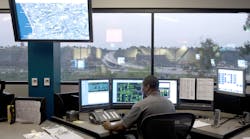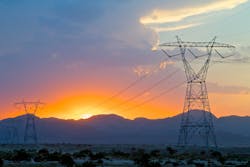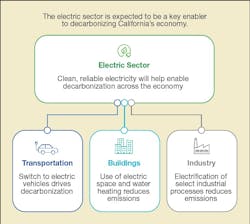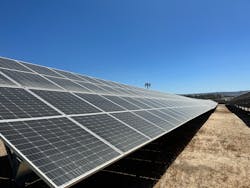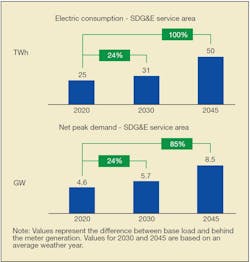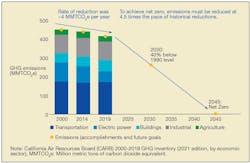The U.S. electric T&D system, also known as the grid, is clearly here to stay. It is a vital national and societal resource to embrace and celebrate. Yet, much like other critical infrastructure, the grid needs to be modernized and enhanced — both to maintain essential standards of safety and reliability in the face of change and to adapt with agility as it integrates and provides new and diverse services.
With these investments, the grid will become even more important, especially because a more sustainable future depends on more people and businesses electrifying through policy, choice and innovation. In fact, San Diego Gas & Electric Company’s (SDG&E’s) recent economy-wide study, The Path to Net Zero: A Decarbonization Roadmap for California, projects electricity consumption will double by 2045, with a corresponding net peak forecast of nearly twice the current level.
Clean, Reliable Foundation
The grid itself is a clean, safe and reliable foundation comprising power infrastructure (for example, wire, transformers and switches) and digital technology (for example, microprocessor-based controllers, phasor measurement units and fiber optic links) that is flexibly integrating cleaner energy supplies at an exponential pace. Most of these resources are interconnected optimally at the transmission level, enabling the state’s electric sector to reduce emissions by 42% over the past decade. In-state electric generation now contributes an estimated 11% to California’s greenhouse gas (GHG) emissions, according to the California Air Resources Board (CARB).
Over the last decade in SDG&E’s service territory alone, which includes San Diego and south Orange counties, approximately 1.8 GW in nameplate capacity of distributed energy resources has been integrated into the grid, an amount of energy nearly equivalent to what was produced by the now decommissioned San Onofre Nuclear Generating Station. Nameplate capacity reflects the maximum output capability and not total energy (watt-hours) produced across
all hours.
Utility investments in innovative, state-of-the-art systems and processes have enabled smaller residential systems like rooftop solar and batteries to interconnect quickly and efficiently with the grid. For example, SDG&E’s Fast Trak process enables customers to interconnect within three days on average. This demonstrates agility and resilience, alongside good planning and customer service, can help to accelerate the clean-energy transition. However, the environment continues to change exponentially. SDG&E’s system peak is about 5 GW, but the utility currently has a transmission interconnection queue exceeding 20 GW.
Grid Of The Future
Fortunately, the last decade brought new opportunities to build or enhance foundational systems. Information about the location and state of the millions of pieces of grid-edge equipment and billions of data points is becoming ever more important. Early adopters have benefited tremendously from fully connected and real-time geographic information systems (GIS), comprehensive deployment of supervisory control and data acquisition (SCADA) and phasor measurement units (PMU), and highly integrated advanced distribution management systems (ADMS) and advanced metering infrastructure (AMI).
These information and communication systems with associated processes support safety and reliability. For example, SDG&E has facilitated the development and integration of hundreds of advanced weather stations, granular sectionalizing devices with remotely toggled sensitive relay profiles, falling conductor protection and incipient fault detection, as well as the use of predictive analytics for situational awareness and wildfire mitigation.
These same operations and planning systems house complex asset characteristics with volumes of corresponding time-series data needed for modeling varying load shapes and multiway flows now seen on distribution systems and in utility-based microgrids, several of which SDG&E has placed in service. They also can create part of the foundation to build and operationalize new technologies to further electrify end uses in people’s daily lives.
Enhance Value
Although well on its way to delivering a 100% clean energy supply, the electric grid must continue to evolve to accelerate decarbonization of other high-emission sectors, such as transportation and buildings, and enhance its overall value to customers and society. Transportation currently accounts for about 40% of California’s overall GHG emissions. Electric vehicle (EV) policy initiatives and consumer incentives are expanding. EV offerings — everything from pickup trucks and school buses to SUVs — are becoming prevalent in all sectors of the transportation industry. Additionally, states and municipalities already are incorporating electrification in building codes and ordinances as they plan their energy transitions.
Clearly, the grid will need to modernize and increase capacity to support the expected increase in energy demand from building and transportation electrification. Utilities will serve new energy needs, many with vastly different schedules and expectations by consumers. These emerging diverse uses will add significant demand and complexity to the grid, yet at the same time create new opportunities for optimization.
Considerations such as customer mix and behavior, an abundance of certain load and resource types, static price signals and lack of load flexibility among others, have contributed to many instances of poor load factors on assets. Reinventing how and where growth in supply and demand occurs and is served can greatly enhance grid usage and value. This should occur and will create opportunities in all aspects of the industry.
Strategic Roadmap
A strategic roadmap is essential to layering in new infrastructure and technology on the grid’s strong foundation while managing affordability throughout this monumental transition. SDG&E is facilitating technology adoption by consumers and market participants through systems and process. The current phase of the utility’s technology roadmap is focused on simplifying operational complexity, driven by volume and diversity, in the human-machine interface and dynamically leveraging resources for greater value. Fundamentally, with so many passive devices interconnected to the grid, standardization efforts, such as those for smart inverters, are needed to maintain safety, security and reliability.
However, as more active and capable technologies proliferate, such as energy storage, it has become a priority for utilities to establish and enhance real-time communications and control across a wide area (for example, 5G). One example is implementing IEEE 2030.5 for both individual resources and aggregations as well as grid enablement technologies, such as distribution feeder volt/volt-ampere-reactive (volt/VAR) optimization devices (for example, capacitors, regulators and inverters).
In addition, the roadmap includes day- and hour-ahead forecasting and analytics of less predictable or masked load and resources, which are becoming a new imperative for control centers.
Mass AMI deployments with less-capable microprocessor-based technology are already 10 years old. However, next-generation performance promises edge computing and communications with diminishing latency to help achieve operationalization.
Finally, prototyping functionality and choosing flexible systems and architectures that allow for layered and configurable capabilities, can create efficiency and reduce costs as consumer and policy expectations grow.
The Long View
Planning far ahead with the best information and focusing on no- and low-risk strategies and investments is essential to keeping pace with energy trends and customer expectations. The industry needs 15-year policy-aligned load and resource forecasts for planning and initiating long-lead-time
upgrades to the less locationally dependent high-voltage transmission system.
Integrated resource plans need to steer toward more T&D technology neutrality and incorporate resiliency by siting sufficient new transmission interconnected resources adjacent to regional load centers to better prepare for more frequent extreme events, such as loss of large transmission corridors (for example, wildfires).
Additionally, streamlining the land-use and permitting process as well as broad interconnectedness and operation (for example, creating regional transmission organizations) also are critical to support grid reliability, while balancing costs that could affect overall energy affordability.
Some of these actions are being either considered or taken regionally, such as by the California Independent System Operator (CAISO), or federally, including through the Federal Energy Regulatory Commission (FERC) notices of proposed rulemaking.
Sustainability And Optimization
Life-cycle sustainable and cost-effective energy storage — including virtual storage or power plants and firm demand response/shifting — remains the holy grail of the energy industry. Current technologies, such as battery and microprocessor-based systems, continue to work through best-fit, longevity and recycling challenges, among others. The industry needs technologies and tools not yet invented.
New ways to generate and store energy, integrate technologies safely and seamlessly, and advance operational systems and functionality must be developed for the grid to reach its full potential while ensuring reliability. Breakthrough technologies like lower-cost, long-duration storage, hydrogen and carbon capture could be game-changers, particularly for the bulk-electric system.
Meanwhile, there also is much to invent and address to enhance optimization at the distribution level. Ultimately, the optimal solutions will not be discovered when bound only to “T” or “D,” but rather found by comparing or integrating the value of both “T” and “D” options.
Choice And Affordability
Providing a great customer experience includes ensuring energy is safe, clean, reliable and affordable. This should always be a top priority for the energy sector. As a wide range of consumers deploy many new energy technologies and software, in an on-demand economy context, expectations around integration and service will only accelerate.
Further, as more end uses are electrified, the grid takes on brand-new or a much larger role in services, previously fulfilled by other energy sources, with differing degrees of criticality for each customer. For example, even with the grid’s high degree of reliability, there will be circumstances where an outage occurs and a customer has not been able to fully charge their electric vehicle. The consequences and alternatives for that limited mobility will vary widely among individuals, businesses and circumstances.
Additionally, grid operational challenges may arise, such as more coincident use and charging after outages. This underscores the significance of progress already made by some utilities related to these new services and how varied implications need to be further understood, so tailored innovations and choice can continue.
The clean-energy transition offers plenty of opportunities for all consumers and participants. Alternatives and pricing, including incentives, will need to be measured on an equitable basis across T&D to manage affordability and ensure grid reliability.
Safety And Security
Assessing risks, maintaining and advancing standards, and ensuring adherence must underpin and keep pace through all transitions. There have been stark reminders worldwide of the existential importance of energy security and diversity. In the information age, when everyone is accustomed to and expects information at the tips of their thumbs, there has never been more interest and participation in the grid.
Digital technology makes grids much more advanced and efficient, but it also can surface new vulnerabilities. Digitalization of the grid and many other aspects of daily life generates tremendous amounts of data. While data analytics fuels innovation, in the hands of bad actors, the same information could enable significant societal attacks. The industry needs to broadly rein in and reevaluate practices to address new and evolving physical security and cybersecurity risks, even in instances where data has been shared already, rather than perpetuate and heighten risks. Further, incoming participants need to be assessed against existing and new standards for the industry. For example, what is the cybersecurity risk to an inverter on the grid, and how does that change when there are millions? Prevention is the first defense, quickly followed by mitigation.
Historically, there typically has been multiple forms of energy and delivery for generating sources, homes and businesses. As utilities turn to the most cost-effective and prevalent forms of renewable sources and storage technology, diversity should be at the forefront of engineering to ensure resilience. It becomes much more complex to assess and ensure grid reliability when analyzing more variable or time-constrained sources.
The regionally networked transmission system interconnects a wide variety of resources broadly to facilitate that resiliency. Very long transmission corridors will continue to be extremely helpful to optimize cost and meet reliability standards, but they also might be prone to interruption or loss during emergencies, such as wildfires. As climate and natural emergencies have highlighted, ensuring a sufficient level of transmission-connected resources in proximity to load centers will be important. For similar reasons, efforts to address aging infrastructure and hardening against these threats also will continue to be a big part of utilities’ future efforts.
Envision The Future
The future of the grid is starting its next big transition now, following a decades-long move from nascent to mainstream availability and adoption of renewable energy, consumer energy tools and digital systems. Significant energy efficiencies have been realized and these technologies are assumed going forward. Society is now pivoting to using much more electricity from the clean grid to optimize and decarbonize other sectors, so a change in mindset and much more agility will be needed as pricing and programs are retooled.
In California, significant opportunities abound on the path to net zero, including expanded markets and regional cooperation as well as plans to further modernize the grid with both infrastructure and technology innovation. The future is bright for the grid. Now is the time to envision, plan and operationalize enthusiastically and thoughtfully the next wave of progress and innovation, with the goal of further advancing the grid’s safety, reliability and value to society.
Alan Dulgeroff (ADulgeroff@sdge.com) is director of electric system planning for SDG&E. In over 20 years at SDG&E, he has served in leadership and technical positions in strategy and finance, HR, IT, and nine areas of electric and gas T&D engineering, construction, operations and maintenance. Dulgeroff is a graduate of San Diego State University with a master’s degree in engineering and BSEE degree with a minor in computer science. He is a member and past Chairman of the IEEE Power & Energy Society San Diego Chapter and graduate of LEAD San Diego 2010. Dulgeroff actively mentors engineers, accounting and finance professionals, serves on Sempra Energy professional development committees and is the past chair of the SDG&E engineering advisory group. He was honored by the San Diego County Engineering Council with the 2012 Outstanding Leadership in Engineering Outreach award and by Sempra Energy as a 2013 Diversity Innovation award finalist. He is licensed in California as a professional engineer in electrical engineering.
